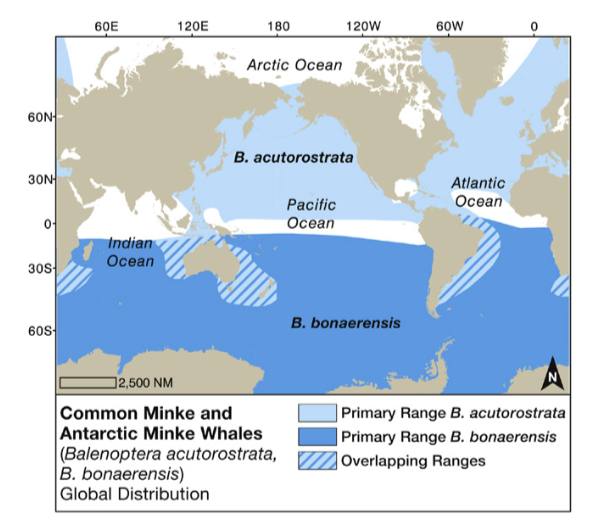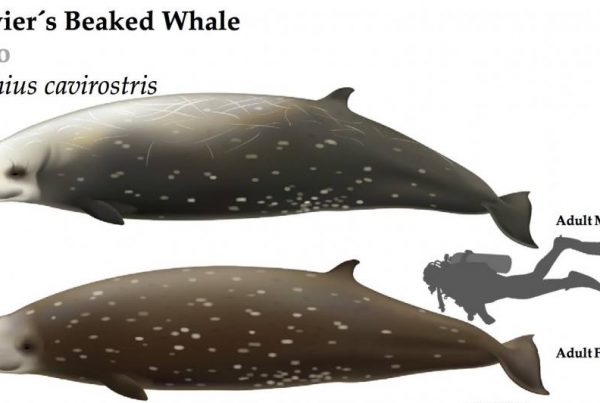
« Minke Whale » (Balaenoptera acutorostrata) comes from a German whaler named « Meineke ». Two stories are told: the first one is that Meineke may have mistaken the small whale for a blue whale; and the second one, Meineke was in the habit of overestimating the size of the whales killed by his boat. To mock him, the others whalers called this whale « Meineke ’s Whale ».

CHARACTERISTICS
- Latin name : Balaenoptera acutorostrata
- Suborder : Mysticeti
- Family: Balaenopteridae
- Length : up to 10 meters
- Weight : up to 800 kg
- Dive time : up to 20 minutes
- Dive depth: up to 200 meters
- IUCN Status: Least concern

Worldwide distribution of Minke Whale (Balaenoptera acutorostrta, B.bonaerensis). Encyclopedia of Marine Mammals IIIrd Ed. Bernd Würsig, I. G. M. Thewissen & KIT M. Kovacs
DESCRIPTION
Color: The back is dark grey, black. In the Northern Hemisphere it has a white band on its pectoral fins.
Head: Small and pointed rostrum.
Fins: The dorsal fin is located a the two-thirds of the body.
Baleen plates: Yellowish, from 270 to 350 plates each side of the upper jaw. 20 to 30 %of the baleen plates are white- light yellow.
Ventral grooves: 60 to 70 grooves, do not reach the mouth.
Blow: up to 2 meters.

A Minke Whale (Balaenoptera acutorostrata) feeding where we can appreciate the extended grooves.
LIFE HISTORY
DIET
Minke Whales feed on krill, young herring, sandlance and capelin. One of their most common feeding techniques consists in rushing in a school of fish from below. It sometimes turns on its sides to swallow its prey.
REPRODUCTION
Sexual maturity is reached at around 6-8 years. Breeding and calving take place towards the end of Fall/beginning of Winter (for the Northern Hemisphere). Females give birth to calves every other year and the gestation lasts about 11 months. At birth, a new born measure around 2.5 meters in length.
SOCIAL BEHAVIOR
Minke Whales are generally solitary or aggregate in small groups of 2 or 3 individuals. They are fast swimmer (up to 30km/h). The Minkes Whales often performs a series of breaches.

A Minke Whale (Balaenoptera acutorostrata) breaching.
VOCAL BEHAVIOR
Minke Whales produce groans, moans. The frequency of the vocalization is usually low-frequency. From 100 Hertz to 12 kHertz. You can listen a Common Minke Whale communicating in this recording collected by NOAA Fisheries.







